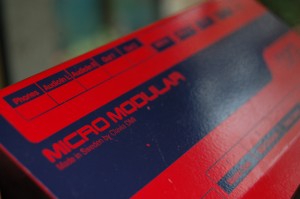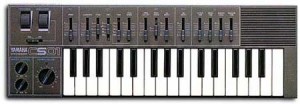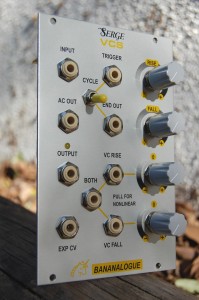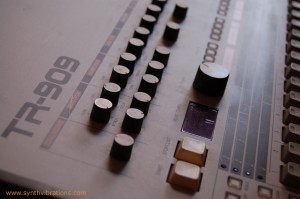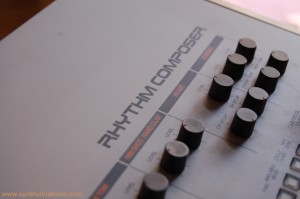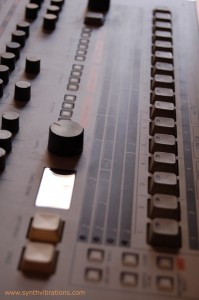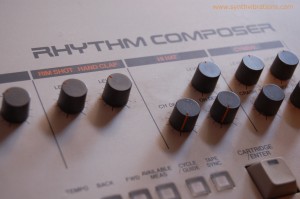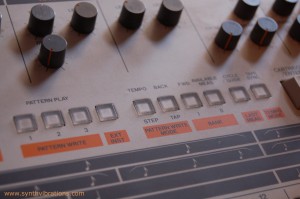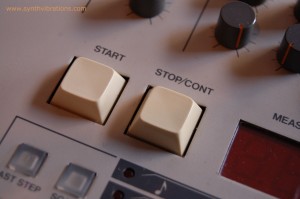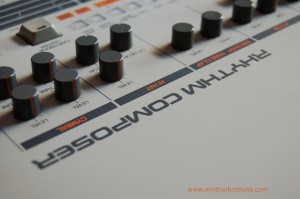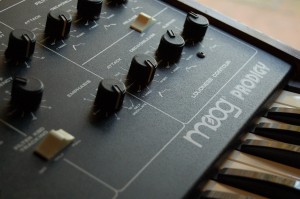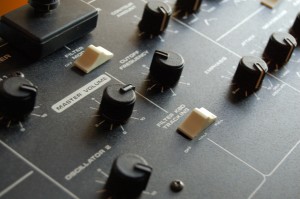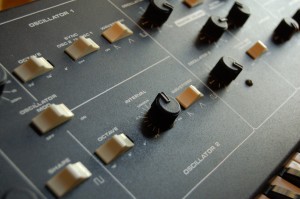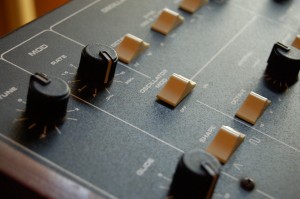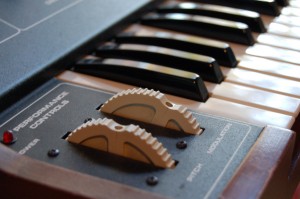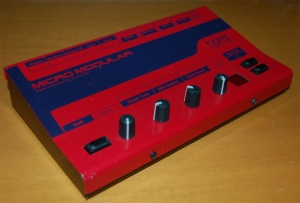The CS-01 is a funky little synth!
It may seem a toy but is a real analog synth in a small case.
The structure is quite simple, justa simple LFO, a “VCO”, VCF and ADSR.
I wrote “VCO” because even if the yamaha labeled it VCO but it is in fact a DCO.
The sound of the oscillator is however real analog, and “phat sounding” in a typical japanese way, and it reminds the classic analog sounds of the early 80’s.
The oscillator offers a good selection of waves (TRI, SAW, SQUARE, PULSE, PWM) and feets(4′ 8′ 16′ 32′ and noise).
The most powerful is the sound of PWM, which is really fat and “wide” sounding.
PWM has its own speed control too (indipendent from lfo).
The LFO is only a tri wave useful for vibratos and wah effects, its not extremely fast, but works well for all the classic sounds.
VCO also have a “glissando” instead of portamento/glide, which means that it can jump from a note to another passing through the notes in the middle.
The VCF is a 12dB lowpass with resonance and EG depth.
The resonance is controlled by a switch that turns it on or off, but it’s possible to modify the control to have a real resonance control adding a knob.
On the MK2 model the filter use a different structure (it has a 24 dB slope instead of 12) and has the resonance controlled by a slider.
The filter is, as other old yamaha monosynth, very smooth and “bubbling”, even with resonance tutned on the filter never eat the low frequency range, offering a wide variety of colour even as a bass machine.
The CS01 is mainly a bass and lead machine, the bass is always rounded, and punchy, for the classic 80’s arpeggio or for techno bass sounds.
On the lead side it can sound quite minimal and smooth or rich using the pwm, it can also reproduce easily the classic retrocomputer sounds !
Despite the toys look with the built in speaker this a lightweight classic 80s monosynth that can do most of the analog mono-sound without any problem of space in the studio and being very reliable.
game consolles and circuit bending
Bliptronic 5000 LED Synthesizer
by synthvibrations • • 0 Comments
“Need a quick and dirty sequencer, or a fun and simple instrument with which to noodle? Bliptronic 5000 is here!”
http://thinkgeek.com/c4e1

The Bliptronic 5000 could be an interesting “music toy” , for 8bit,glitch or bending.
I think I’ll get it!!
videos
MPC1000 & Mini Kaosspad session
by synthvibrations • • 0 Comments
A great jam session with Akai MPC 1000 and the Korg MINI KP from nicoluminous youtube channel.

modulars
Bananalogue Serge VCS is back!
by synthvibrations • • 1 Comment
Bananalogue is reintroducing a new stock of their Serge VCS.
For now this is just how it looks, I’ll post soon any info I’ll get.
photo gallery
Roland TR 909 photo gallery
by synthvibrations • • 0 Comments
Here are some close up shots of my Roland TR 909 Rhythm Composer …
3/4 left side shot kick and snare and the TR 909 logo…
..now the right side with rimshot, handclap hi-hats and cymbals…
…the awesome 16 step buttom rig with C64-like buttons…
…close up shot of percussions and hi-hats section..
…pattern selection and programming buttons…
…the start and stop buttons…
…Rhythm Composer…
videos
Charles Cohen at the Buchla Music Easel
by synthvibrations • • 2 Comments
photo gallery, retrò & vintage, synthetizers
Moog Prodigy – review
by synthvibrations • • 11 Comments
When it came out in the late 70s the Moog Prodigy was the moog attempt to fight the “japanese invasion”, so it was a stripped down version of the minimoog at a competitive price.
It was really popular indeed and was a big american “budget-Mini” till Sequential Circuits made the Pro One.
The structure is quite simple: a 2 syncable VCOs with the classic 24dB moog ladder filter, two ASD/R and a simple lfo.
The two vcos are similar but they have different waveforms and different “feet” settings.
VCO1 has the 32′ and offers Pulse, Saw and Tri waveforms.
VCO2 has the 4′ and TRi, Square and Saw.
The second vco has a detune knob and can be synced to vco1 creating many complex waves (a feature unavailable on the Minimoog).
Using the Pitch Wheel with the sync on , the wheel “move” only the VCO2 creating big alterations in the waveform content.
Than there is a mixer/vca part , the Filter with cutoff, (env)Amount, and Emphasis (resonance) and the two envelope ADS/ASR.
The LFO is quite simple and offers square and tri waves with a rate control that can go from 0.3Hz to 30 Hz, not the faster or slowest lfo, but really useful.
The most interesting part of this synth is the behaviour of the filter that is indeed the strengh of all moog synths, a really organic, warm and brilliant sounding!
It sounds always balanced, the resonance can get quite acid and never get thin.
The vcos are really capable, rich and armonic over all the audio spectrum, and the sync is a top notch feature in a simple synth because the vcos interact very well creating complex waveforms that sound always usable.
The behaviour of the envelopes is really interesting, they are snappy and fast, but they move in a really organic and “natural” way.
Even the 3 stage concept is not limitating at all.
All in all this is a great vintage synth that is always quite cheap compared to the always rising prices of Minimoogs, and though it may seem quite basicv/simple, getting in depth with it can lead to a very wide range of sounds, some even typical “Prodigy trademarks” , not only mini emulations…
Compared to the new analogs (moogs and moog clones) the prodigy has a particular fashion that set this synth aside from the new generation, and it’s all about the sound!
While the Prodigy has a raw but harmonic sound that’s always present and creamy, today’s synths are more “bright” but not brilliant, the sound is cleaner and more defined, when you turn the cut off down they are smooth and quite flat/static , while the prodigy always seems to oscillate wildly under its wood and metal case…
My prodigy has two interesting MODS.
- FILTER FM : the vco2 can modulate the filter frequency creating wild sounds, from vocal-like textures to noise or drones.
- CV-GATE MOD : a standard cv-gate interface instead of the moog s-trig.
I chose to have this mod because my model (an early BX336) did not have any control socket.
I’ll provide photos of the mods in a future post 😉 , stay tuned!
modulars, videos
Livewire Vulcan with Sync reset Mod
by synthvibrations • • 0 Comments
Really interesting video from intellijel youtube channel of the Livewire Vulcan modded with sync reset.

Description by intellijel :
Demo of a mod done to the Livewire Vulcan to allow independent reset of the two LFOs.
To the right of the Vulcan you can see a 4HP panel with the two jacks mounted, behind this is a circuit board designed to interface to the Vulcan and process incoming triggers.
Jack1 is normalled to Jack 2 so that one cable can trigger both resets. Modules used: MFB SEQ-01 (provides the triggers) Livewire AFG (single oscillator that is being modulated) QMMG (not doing anything until the later parts where I modulate its in LPG mode) Doepfer VCA (just being used as an attenuator) The SEQ-01 could be replaced by any source of rhythmic triggers including gates from your midi to cv converter.
The demo starts with no sync and simple modulation and then I start to patch more complex triggers and cross mod. Sorry for the poor quality! I forgot to turn on the camera light…. future videos will be better  Also this mod is not for sale but I can provide instructions… it is not for beginners though. I plan to add switches for selecting mod sources and jacks to patch in external CV to the SUM/DIFF/MAX/MIN circuits
Also this mod is not for sale but I can provide instructions… it is not for beginners though. I plan to add switches for selecting mod sources and jacks to patch in external CV to the SUM/DIFF/MAX/MIN circuits
videos
Clavia Micromodular plays Aphex Twin…
by synthvibrations • • 0 Comments
synthetizers
Clavia Nord Micromodular – overview
by synthvibrations • • 0 Comments
The little red metal box is really the pandora’s box…
Basically the micromodular is a dsp programmable virtual modular synth with 24bit 96KHz audio conversion.
The box is little but solidly well built, there are a stereo output, stereo input, a couple of midi ports for midi control , a couple of midi ports to “pc control”, dedicated to the editor.
On the front we have four knobs (volume+3 assignable controllers) and 3 buttons.
The interface is quite minimalistic because the instrument is thought as a small/lighter version of the Nordmodular and the aim is to control it by sw and midi controllers.
It’s quite difficult to start a description of a so open-ended and complex instrument, I’ll try to keep things simple…
When you open your editor on the pc/mac it will show the current patch (the micromodular is a monotimbral instrument).
The modules are grouped in categories and it offers from the classic oscillators, envs, lfos, and all the classic “analog-modular modules” to the newest digital effects like bit reducing, warp, digitizer…
This thing is like a little reaktor in a box with an awesome sound.
It can do classic synth sounds with a little of modular twist as well as complex rhythmic morphing and glithching.
The original editor from clavia is compatible till windows XP, but now a free java editor is available , NOMAD .
Nomad let you edit the nordmodular serie with every system that supports java.
The nordmodular serie is not dead, clavia will not add new modules, but the instrument is alive with nomad!
